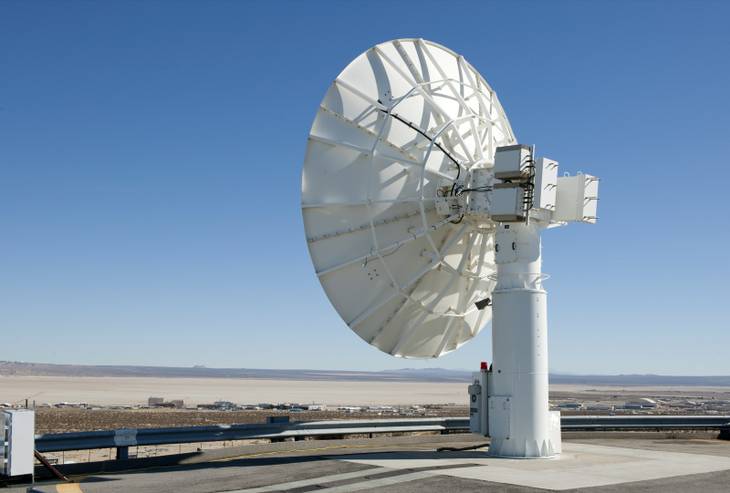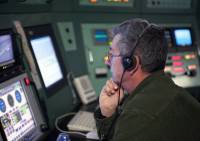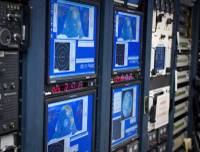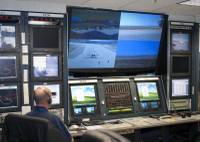Related story
It’s an unusual winter morning in the desert surrounding Edwards Air Force Base in Southern California — unusual in that the wind isn’t howling across the dry lake beds, Joshua trees and low-lying scrub.
It’s easy to hear but not see jets from the base as they pierce the cloudless sky, and you’d almost swear you could hear echoes of flights more than 50 years ago in the area by such heroes as Neil Armstrong, Alan Shepard, Gordon Cooper and superstar test pilot Chuck Yeager during the lead-up to America’s manned space program.
Within Edwards’ boundaries is NASA’s Dryden Flight Research Center and, nearby, a small office for Arcata Associates, a Las Vegas aerospace company founded in 1979.
On this day, the Dryden Flight Research Center is conducting tests on minimizing the startling impact of sonic booms, the concussive noise generated when planes travel through the air faster than the speed of sound.
Almost on cue as Arcata executives gather in a conference room, the windows rattle and the wall shakes.
“A sonic boom,” Arcata CEO Tim Wong says.
In a way, the company is like the planes above Edwards — it’s making noise but remaining largely out of sight at the same time.
Arcata is a multimillion-dollar company that has twice been named NASA’s Small Business Prime Contractor of the Year, including last year, yet many Las Vegas residents don’t know it exists.
“With the major economic drivers in our community being hospitality, gaming, construction and real estate development, the aerospace-defense sector does not receive much attention,” Wong said. “In other areas of the country such as Huntsville, Ala., Dayton, Ohio, and Washington, D.C., aerospace-defense is a highly visible economic sector and receives tremendous attention and support from their local press and business community.”
Make no mistake: Arcata is a big deal at Edwards. The company provides monitoring and information technology services for NASA and the military, and is involved in a series of projects ranging from development of landing equipment for a Mars rover to measuring of polar ice sheets.
“Arcata is a key part of the team here at Dryden,” said David McBride, the center director, from his office filled with models and memorabilia of NASA’s storied history at Edwards. “We were really pleased for them when they were named 2011’s Small Business Prime Contractor of the Year.”
But it wasn’t that long ago that Wong and his colleagues were on the verge of seeing Arcata crash and burn.
Tim Wong’s father, Buck, an aerospace engineer and former Navy officer, started Arcata Associates in 1979 in Burlingame, Calif.
Buck Wong named his company after a Native American word meaning “a place by the water,” because he could see the San Francisco Bay from his office window.
Capitalizing on what then was a new Small Business Administration program to deliver military contracts to small companies, Buck Wong got his first major contract at Nellis Air Force Base. He moved the company to North Las Vegas, where he built a core of technical expertise and won a variety of military contracts.
Before long, he got several military jobs and Arcata flourished. It added operations in Arizona, New Mexico, Louisiana and Idaho, all supporting Air Force air crew combat training ranges.
The fall of the Berlin Wall in 1989, however, signaled the beginning of the end of many of the contracts. Military contractors were devastated as bases closed and contracts ended.
Growing weary of laying off people who had been with the company for years, Buck Wong was down to one contract, with Nellis, in 1993 and called on his children for help.
“I was planning to go to law school,” said Tim Wong, who received a business degree from the University of California at Santa Barbara in 1984.
He wanted to pursue a career in advocacy for environmental groups, but his father persuaded him to get some hands-on business experience at Arcata before pursuing a law degree. His sister, Nancy, who worked for the Commerce Department in China and held positions at Hewlett-Packard and Columbia Pictures Entertainment after graduating from UCLA, was persuaded to help, and Tim agreed to take the CEO position temporarily.
“I enjoyed the work, but I really was going to leave and I didn’t want to leave the company in the lurch,” he said.
Wong decided to pursue a contract renewal at Nellis. Failure would have meant shutting down the company.
“Our options were letting the contract run out, selling the company or giving it a go ourselves,” he said. “We really had some soul-searching to do. Neither of us had really dreamt of running this company, but it was a unique opportunity and the company had a history of strong performance.”
Wong said he knew Arcata had strong people within the corporation and that if they won the Nellis contract, he could try to change its path by diversifying its business, customer base and revenue.
“We were fortunate that the Air Force picked us,” he said. “It gave us a five-year window to change things.”
Wong said one of his first targets was NASA, “an agency that’s always fascinated me personally.”
He knew it wouldn’t be easy to win a job as a prime contractor for NASA, so the company first pursued subcontracting work for a major player. Arcata built a relationship with Bethesda, Md., aeronautical contractor Lockheed Martin and began working on one of its projects.
Before long, the company was plugged into the Jet Propulsion Laboratory in Pasadena, Calif., the Goddard Space Flight Center in suburban Washington D.C., the Marshall Space Center in Huntsville, Ala., and the White Sands Test Facility in New Mexico.
“By 1999, the company took off, and we’ve won a number of prime and subcontracts with the agency (NASA) since that time,” Wong said.
Arcata pursued a coveted 10-year contract to provide engineering, operations and maintenance IT and multimedia support of the research center’s test range in 2002. That means Arcata engineers monitor all of Dryden’s test flight experiments, providing real-time data and recording and storing test data for further analysis.
Much of the data are gathered from radar and telemetry dishes. Every monitor feeds into data-processing centers that are displayed for NASA engineers and archived for later analysis.
Sometimes, Arcata employees fly on the test missions, either in the seat behind the pilot or on chase planes trailing the test vehicle.
“It’s critical that we get this right,” said Anthony Ng, executive vice president of Arcata, who oversees activities at Dryden from the corporate office in Las Vegas. “Most of the time, you only have one shot at it.”
Arcata’s engineers have a broad range of technical expertise and are involved in system design, software development, hardware design and development. The staff includes photographers and videographers who shoot images during tests and for public affairs purposes.
Whenever a space shuttle lands at Edwards, for example, the footage that goes to news bureaus worldwide is shot by Arcata employees.
Arcata employs about 400 people in eight states, including a core group assigned to projects at Dryden. About three-quarters of Arcata employees have top-secret security clearance due to the sensitive nature of the work at the base.
Wong and his team got word of the NASA contractor award late last year. It was the second time in four years that Arcata won the award, which is based on performance scores, responsiveness, cooperation and innovation and given to the best small contractor from among 12 NASA centers, laboratories and offices across the country.
Arcata’s performance scores were among the best ever among NASA contractors.
“The evaluation process is like grading in school, with an A, B, C or D,” Wong explained. “A score of 90 and above is considered ‘excellent.’ In a recent run, we had 18 in the excellent category, 15 in a row above 95 and 99s on three out of the last four evaluations.”
But what really amazed evaluators was that most of the Edwards-based Arcata employees formerly worked with Spiral Technologies, the company that held the Dryden contract prior to Arcata. Spiral didn’t score as well, leading NASA officials to conclude that it was something in Arcata’s management style that led to the better performance.
Wong said most of it is a matter of putting personal touches on relationships with employees.
In his meeting with staff at Dryden last month, he opened it by passing out red envelopes with Chinese inscriptions containing a traditional good-luck dollar in commemoration of the start of Chinese New Year. Sure, it wasn’t much, but it was a small token of appreciation and a personal touch that was part of the Wong family’s heritage.
Tom Wilczek, the new defense and aerospace industry specialist for the Governor’s Office of Economic Development, said Arcata and companies like it could play a key role in the diversification of the state’s economy.
“The problem has always been that contractors come in and have their support facilities here in Nevada,” Wilczek said. “They do their job well, but when the contract comes up, they lose the contract and they leave because they can only grow to the degree of available funding.
“But Arcata is based here and recognized as top in class and with that, they have the ability to grow. With more licensing possibilities, they provide unique opportunities not only to Nevada, but across the United States.”
So what’s next for Arcata?
One of the top priorities will be pursuing a continuation of the NASA contract with Dryden.
Ng says within weeks, the company expects to hear about the process of either extending Arcata’s current contract or receiving a request for proposals for a new contract.
The company is expected to make a strong bid to continue its work.
“One of the things people always ask me is, ‘Now that the manned space program is over, are you out of business?’ Actually, there’s a lot of opportunity, especially with private enterprise taking on more things,” Wong said.
Arcata is supporting Lockheed Martin on the Orion program, the development of a next-generation space vehicle that is expected to take astronauts into low Earth orbit as well as on deep space missions to asteroids and Mars.
Arcata still monitors activities on the International Space Station, even maintaining an inventory of what experiments and equipment are taken to the orbiting laboratory and what is removed.
While Arcata doesn’t work with another Southern Nevada aerospace company — North Las Vegas-based Bigelow Aerospace — Wong said he’d like to. Bigelow is involved with developing inflatable space station modules that will enable scientists to work in zero-gravity conditions.
Robert Bigelow, the head of the company, has negotiated with scientists and governments from several countries to provide a workplace for a variety of experiments.
Wong’s team has all the pieces in place.
For him and Arcata, the sky’s the limit.



